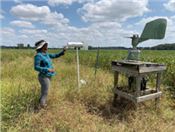AgCenter Researcher Awarded $325,000 Grant To Study Cercospora Leaf Blight
BATON ROUGE, LA.
Cercospora leaf blight has been a bane to soybean farmers in the mid- South region of the United States for the better part of two decades, costing the industry more than $250 million in the past five years alone. Now, thanks to a three-year, $324,988 research grant from the National Institute of Food and Agriculture, LSU AgCenter plant pathologist Sara Thomas-Sharma and her team are trying to develop long- term solutions to the problem.
In her project summary for the NIFA grant, Thomas-Sharma laid out three research objectives to assist soybean producers in protecting their crops, which are valued at $41 billion annually in the United States. First, determine the importance of air-borne spores in the disease cycle and identify environmental predictors associated with disease development; second, develop tools to monitor resistance to commonly used fungicides; and third, integrate improved fungicide application timing and host resistance in Cercospora disease management.
Thomas-Sharma said the collaborative grant between Louisiana, Arkansas and Mississippi is meant to assist growers directly.
“Management of this disease has had a lot of challenges because much was not understood about where it was coming from,” Thomas-Sharma said. “We have reason to believe that it is coming in as spores, so the first objective is to set up spore traps to try and understand when the peaks may occur.”
The spore traps are set up in multiple locations and come in two different types: one surprisingly simple, the other more complex. The simple trap consists of a wind vane containing a microscope slide coated with petroleum jelly that catches the spores when the vane moves. The other, more expensive type is connected to a power source that sucks air onto a paraffin-coated tape.
Thomas-Sharma’s second objective addresses the question of resistance to some of the less-expensive commercial fungicides. Up to now, there have been few in-depth surveys in the mid-South on where resistance does and does not occur.
“If there is no resistance problem in a certain area, it makes more sense for the grower to just apply the cheaper fungicide,” she said.
“But if there is, applying the cheaper fungicide won’t do any good and will just be a waste of money, so we’re developing a method where we can quickly monitor the level of resistance throughout the three states.”
According to Thomas-Sharma, Cercospora comes late in the growing season, close to when pods are maturing. The leaves begin to turn a purple color, then get leathery and burnt, causing a reduction in yield because there are no leaves to provide photosynthesis.
Thomas-Sharma’s third objective is to target the spore peaks identified in the first objective for timing fungicide applications better. She said growers are currently advised to spray crops during the reproductive growth stage (R3 to R5). She wants to determine if it’s possible to accurately time the application when the spores are high to get better control of the disease.
“This is where we’re trying to put the results from the first objective into use,” she said. “If you have a susceptible variety, and have to use a fungicide, when is the best time to do it to provide the most protection to the crop and does it necessarily depend on growth stage.”
Currently, Cercospora is a bigger problem in the South than it is in the Midwest or other larger soybean-producing regions of the U.S.
While Thomas-Sharma’s research focuses primarily on the mid-South area, Cercospora could become a bigger problem for more northern regions in the future, she said.
“There is always a concern that with weather patterns changing that the disease can move,” she said. “So there is a broader long-term impact of the research as well.”
Thomas-Sharma said her goal is to come up with answers for growers on how to manage Cercospora to better protect their bottom lines. She said it’s almost a given these days that soybean growers in the South will get the disease on their crops; the question is how to minimize its effects.
For her personally, the NIFA grant represents the third time being the charm.
“This is my third try submitting a fairly similar proposal,” she said. “It feels good to see the work and effort finally materialize into something the growers can actually use.” ∆

Graduate student Nelomie Galagedara works on collecting spore samples in the field. The work will continue as
part of a nearly $325,000 National Institute of Food and Agriculture grant to study Cercospora leaf blight.

Nelomie Galagedara is seen here using both the simple wind vane spore trap and the larger one, which uses paraffin-coated tape and is connected to a power source.
Photos by Maria Izabel Costa de Novaes/LSU AgCenter